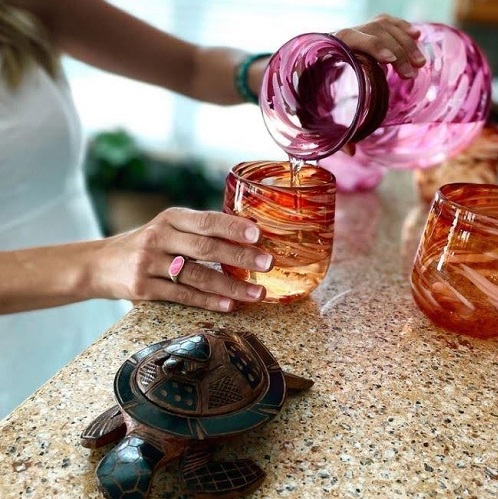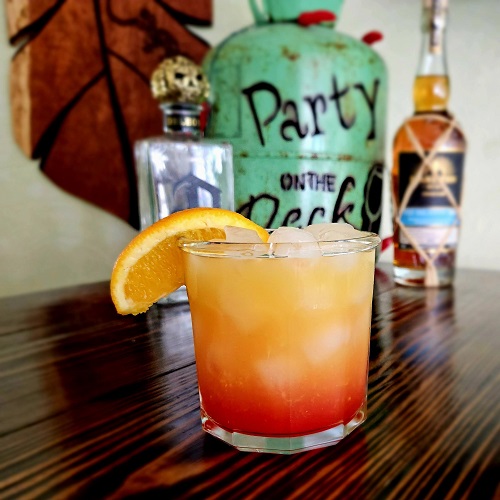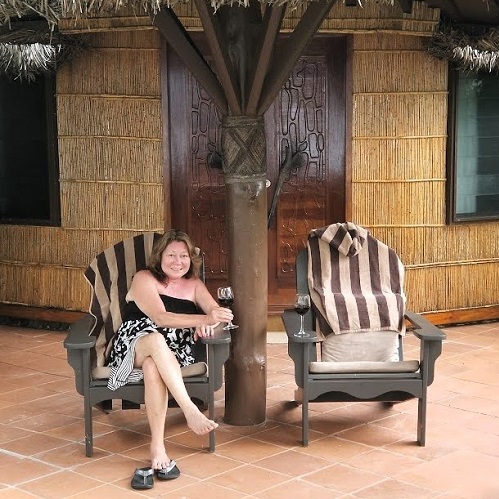
What Are the Different Styles or Themes of Tiki?

Fijian Warrior Club Guide: The Beauty and Cultural Significance of These Tribal Weapons
Tropical Color Palette Ideas for Every Room
Find The Perfect Paint Color and Give Your Home An Oasis-Like Makeover With Tropical Color Combinations
Most people would love to escape to a breathtaking, exotic, faraway island like Fiji, the Maldives, Phuket in Thailand, or the Cook Islands. Being by the ocean rejuvenates the mind and the body. It calms you and it creates contentment. The blissful weather, stunning beaches, crystal clear waters, and spectacular scenery of
But when life doesn’t allow you to escape to a sun-soaked sanctuary, you can create the atmosphere of an exotic destination at home simply by painting with a
To help you find the right color combination, we have compiled a collection of 10 ideas for every room in your home. Whether you prefer a laid-back beachy coastal look, a bright Caribbean color scheme, or a vibrant and adventurous
Which Colors Describe Tropical and Coastal Themes?
Tropical color palettes are known for their bold and bright shades which reflect the vivid tones of the ocean, of rainforests and their exotic birds, flowers, and fruit, of sunrises and sunsets, and of the surrounding environment. They combine organic, neutral tones with rich and deep hues. They are inspired by:
- Sunrises and sunsets (banana yellow, burnt orange, subtle tangerine)
- Tropical water and bright sky (turquoise, sapphire, sky blue, slate blue, indigo)
- The sand and crashing waves (off-whites such as ivory, bone, eggshell, and vanilla)
- Tropical woods (chocolate, mahogany, umber, coffee, deep taupe)
- Rainforests and exotic wildlife (emerald, jade, fiery reds and pinks, vibrant fuchsia)

A
Photo Credit: Decorilla
On the other hand, coastal palettes feature pastels and muted colors which are less vivid and are more subdued. These can be both cool and warm while evoking feelings of relaxing at the coast. They are inspired by:
- Earthy tones (terracotta, camel, muted orange)
- Sunlight (pastel yellow, flax, muted gold)
- The sea and sky (sky blue, navy, turquoise, azure, aqua)
- The seashore (ivory, eggshell, seashell, linen, taupe, sandy beige)
- Coastal plant life (teal, soft green, seafoam green, sage)
- Florals (coral red, sienna, salmon, blush pink)

A coastal color palette
Photo Credit: Decorilla
How To Choose The Best Color Palette For Your Space
With hundreds of paint colors available, you may find it difficult to pick the right color spectrum. We have gathered a few helpful guidelines here that should help you with your selection process:
- Look for inspiration at home – Sometimes your favorite piece of furniture or items such as handcarved wood pieces, wall art, or a really cool vase feature the colors you may want to use on walls. Use those to ensure that you choose colors that go well with your pieces in the room – tables, bookcases and cabinets, sofas, chairs, headboards and bedroom pieces.
- Highlight architectural features – Intricate detailing found in crown and window molding, chair rails, wainscoting, and other millwork are easily emphasized using lighter or darker shades of paint.
- Examine your room size – Lighter colors will make a small room feel larger while darker colors will shrink the space and make it more intimate. Lighter colors on the ceiling will make it appear higher while darker colors will lower them.
- Consider your light sources – Different light sources (available natural light and artificial lighting) affect paint colors differently so try small samples on your walls first, If possible. Some stores sell samples which you can test on your wall. If samples are not available, choose the next lighter shade up from your choice on the color card since paint darkens as it dries. To save yourself some frustration and potentially wasted time and money, we highly recommend that you read our separate section called “Start With A Color Palette” about how lighting affects paint color cards and the paint color itself.
- Unify the look – Opt for various shades of the same color palette to achieve a continuous flow and cohesiveness across all rooms. Another way to connect the rooms is to use the same neutral paint for all the doors and trims.
- Consider the use of the room – Many people prefer warmer colors such as earthier tones for social areas of their homes such as living rooms and family rooms while choosing cooler colors such as blues and greens for more intimate spaces such as bathrooms and bedrooms. Of course, the choice is yours as the goal here is to create your own personalized space!

Find color inspiration in your favorite items
Photo Credit: Mood Board
Color Psychology
Color psychology explains how colors affect human moods, emotions, productivity, and behaviors. From bold and vibrant colors which energize a room to calm and soothing ones which create serenity and peacefulness, colors are very powerful when creating different scenes and atmosphere in the home, more than most people realize. Here’s how tropically inspired colors and their various tones and shades can impact you.
- Green (emerald, lime, mint, jade, etc.) – Green is a cool color which symbolizes vegetation, forests and life. It is considered to be the most soothing color for the eyes. Green has positive effects on your wellbeing by helping you focus and relax. It is excellent for quiet living spaces and bedrooms.
- Blue (aqua, turquoise, cerulean, indigo, etc.) – Blue is a cool, non-aggressive color known to exude peace and serenity by resembling the ethereal beauty of oceans, seas, and skies. It is commonly used in home offices and in bedrooms.
- Yellow (amber, gold, mustard, lemon, etc.) – Bright and cheerful, yellow is a warm color that lifts moods and boosts optimism which is why it is often chosen for living rooms and kitchens. Only the most pale shades of yellow are considered to be suitable for sleeping areas such as bedrooms.
- Pink (salmon, coral, flamingo, rose, etc.) – Pink is both a warm and a cool color depending on its shade and how it is used. It falls on the red spectrum and red is a warm color. However, when lighter shades of it are used or when it is used in combination with other cooler colors, it becomes a cool color as well. Pink is usually associated with the feelings of nurturing, compassion, and love. It reduces aggression, tension, and stress.
- Orange (tangerine, papaya, saffron, pumpkin, etc.) – Orange is a warm color which stimulates socialization, confidence and the sense of adventure. Thus it is suitable for many rooms including living rooms, dining rooms, playrooms, and sunrooms.

Photo Credit: Singh Homes
Choosing The Best Color For Every Room
When choosing colors for your home’s interior, think of how each space will be used and try to match the color to the room’s purpose. Do you want the space to be full of energy or should it be quiet and serene?
Kitchen and Dining Areas
For these spaces, vibrant shades that stimulate conversation, socializing, and even the appetite such as yellows, oranges, and reds are the best. Just be sure that you don’t allow the color you choose to overpower the space. To play it safe, you can choose a neutral color for the walls and use yellows, reds, and oranges as accent colors. Consider colors such as Benjamin Moore Tropical Orange or Friendly Yellow by Sherwin Williams.
Living Rooms
As living rooms today are more and more connected to the kitchen in open floor plans which often results in large, open spaces, you can use more than one shade of a color or similar colors to break up the space to achieve a single, harmonious and balanced look. If you have a separate or closed off space such as a formal living room or informal family room, you may want to consider sandy or earthy tones like Toffee Crunch by Behr and then pair them with brightly colored accents.
Bedrooms
As the primary purpose of the bedroom is for sleeping, you want this space to be relaxing and restful. Blues and greens are typically the best color choices. They are cool and calming which is what you want when creating a peaceful environment. Try Hawaiian Ocean by Kilz or Benjamin Moore Hunter Green. Use a variety of accents and artwork in neutral colors along with a few pieces that are in richer and deeper colors to finish the look.
Outdoor Spaces
As far as outdoor spaces are concerned, the possibilities are endless. We will have a separate post about using
Types of Color Schemes
- Monochromatic– This combination involves using different shades of one color. For instance, using various shades of blue from sky blue to indigo will create a monochromatic look. The contrast here is lower than in other schemes.
- Analogous– Use colors that are next to each other on the color wheel, such as green and blue.
- Complementary– This is a combination that includes colors positioned opposite each other on the color wheel. Using this technique, you can create a striking focal wall effect.

Photo Credit: All Business Templates

Photo Credit: Style By Emily Henderson
How To Test Paint Color
Before you begin painting, you should test the colors. Again, paint darkens as it dries. Your available lighting will change how these colors look so it is vital to view your paint samples in different lighting conditions throughout the day.
To test the color, paint a few small sample sections on different walls of the same room to see how they look both during the day and at night with the lights on. Paint one coat and let it dry. Then apply a second coat to ensure none of the old color comes through. Or if your paint is a primer blend, then one coat should suffice. If you are unable to paint directly on the wall due to there being wallpaper or some other existing wall covering, use a piece of cardboard, poster board, or plywood.
10 Tropical Color Combinations to Create Your Own Paradise
Laid-back, soothing and cool tones are key in
1. Dining Room With Flair
Have you ever wondered why so many food chains and restaurants have red in their interior and exterior design? It’s because red is believed to increase appetite by stimulating the metabolism, making you feel hungrier. You can choose reds that are inspired by bromeliads, red dragon fruit, or even the red macaws found in
Pair reds with earth tones from beige to chocolate, or even blue-grays for a cool, modern vibe.

Photo Credit: Forbes Global Properties
2. Caribbean Style Bedroom
What a better way to create a completely tranquil and soothing atmosphere in your bedroom than to paint it in pale blue. Combine it with an off-white shade such as a seashell color for the ceiling and trim and then bring in accents that are in warm brown and turquoise. Don’t overdo the accent colors because the true coastal and beach style of decorating is all about lighter tones and finishes, and relaxed vibes. This Caribbean style bedroom is airy, light, and serene with a focus on natural hues and elements.
Pair light blue with off-whites, tan, dusty rose, soft grays, and peach to achieve the subtle tones of white sandy beaches in the Caribbean.

Photo Credit: HGTV
3. Ocean-Inspired Kitchen
This kitchen features a rich and lively dark teal color which does not overpower. The space is very well-balanced as the combination of wooden accents that are in warm browns which are reminiscent of a
Pair dark teal with gold and darker yellow, orange, white, and black for bigger visual impacts.

Photo Credit: Country Living
4. Turquoise Bathroom
This vibrant blue resembles a dream-like beach setting with the sun glittering upon translucent waters. The intensity of this hue is offset by a touch of cool green undertones which makes it a fantastic accent color for any room of your home. Pictured here, we see a modern, double-vanity bathroom that exudes island vibes. Wall paint similar to the tile color shown in the picture is SW 6950 Calypso by Sherwin-Williams.
Pair turquoise with beige, warm browns, greens, oranges, and corals to keep the room balanced.

Photo Credit: Red Cottage
5. Luxury Master Bedroom
This master bedroom is proof that with the right wall paint and furnishings, you can create a luxury hotel experience at home. Once you enter this room, you can lay down and unwind after a busy work day. The key here is to achieve a soft and serene space by choosing the color that will soothe you to sleep and enable you to feel refreshed and rejuvenated in the morning. Color psychologists suggest shades of blue as being the best colors for a bedroom (periwinkle, powder blue, peacock blue, etc.) while Feng Shui suggests that the ideal choices for bedroom walls are both green and blue for wellness paired with rich tones like terra cotta, coral, tan, and cocoa for stability and grounding.
Pair blues and greens with crisp white, greys and silver, lilac, alabaster, and pale yellow for a complete calming effect.

Photo Credit: Design Lifestyles
6. Coral Guest Room
This guest bedroom features coral pink walls accented with white windows and trim. The trim could also be painted in a soft blue, light gray, or beige as all of these would create a beautiful and soothing look. Coral pairs very well here with the dark floors and the dark headboard. When used correctly, coral hues evoke a sense of being next to the ocean under clear skies in a beachy atmosphere.
Pair coral with greens, camel, toasty browns and even black for an inviting and welcoming vibe.

Photo Credit: Design Addict Mom
7. Aqua Nursery
You can use a
Pair pale aqua with light blue gray, white, light taupe, charcoal gray, white, or dusty orange for more contrast.

Aqua blue nursery walls
Photo Credit: Project Nursery
8. Mustard Yellow Living Room
Here’s a fun, playful, and eclectic living room, which is bursting with color that promotes happiness and conversation. Yellow is bold and vibrant but don’t be afraid to use it in spaces such as the living room. For the sake of comparison, just imagine if this entire room was painted in this shade of yellow. Most people would agree that it would be overwhelming. But as it is used here, it creates a truly cheerful place for you and your guests. After all, there’s a reason why it is called a living room – it is a place where a lively atmosphere is nurtured.
Pair mustard yellow with leafy green shades, pale to medium wood tones, neutrals, blues, and black.

Photo Credit: Decorilla
9. Peach Entryway
These lively and vivid peach walls with coral undertones make this entryway a bright and cheerful place that warmly welcomes guests. This balanced and
Pair peach with neutrals, blue, maroon, and darker green.

Photo Credit: Amanda Webster Design
10. Neutral Home Office With Tropical Touch
The most important thing when choosing a color for your home office is to ensure it helps you to concentrate and be productive. The space must be comfortable. Neutral colors in this picture are a great example of non-distracting shades that will help you stay focused throughout your day.
Pair neutrals with other light earth tones, greens, greens, browns, cocoa.

Photo Credit: Decoist
Final Thoughts
We hope this post and these color combinations have inspired you to come up with your own
For Further Reading:
- Bring Paradise Home: 20 Tropical Living Room Ideas for Every Budget
- Transform Your Bathroom: 20 Inspiring Tropical Design Ideas
- Tropical Wall Décor Ideas: Infuse Your Living Space With Tropical Vibes
- 8 Easy to Grow Indoor Tropical Plants: Planting Guide & Styling Tips
- Tropical Outdoor Living Room & Patio Ideas
- Create Your Dream Escape: 20 Tropical Backyard Ideas











